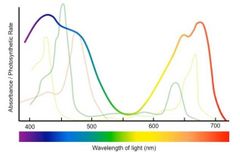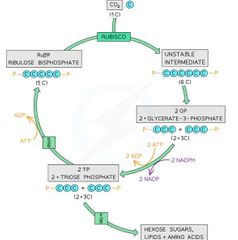![]()
![]()
![]()
Use LEFT and RIGHT arrow keys to navigate between flashcards;
Use UP and DOWN arrow keys to flip the card;
H to show hint;
A reads text to speech;
19 Cards in this Set
- Front
- Back
|
Photosynthesis |
Light energy from the sun is transformed into chemical energy and used to synthesis large organic molecules from inorganic substances. |
|
|
Autotroph |
Organisms that use light energy or chemical energy and inorganic molecules to synthesise complex organic molecules |
|
|
Heterotroph |
Organisms that ingest and digest complex organic molecules from other organisms, releasing the chemical potential energy stored in them |
|
|
Chloroplast Structure |

|
|
|
Chloroplast Adaptations |
Inner membrane is selectively permeable and has transport proteins, Stroma is the fluid that fills chloroplasts and contains enzymes for Light Independent Reactions. Thylakoids are stacked (Grana) to increase SA. |
|
|
Photosynthetic Pigments |

Molecules which absorb light energy, each pigment absorbs a range of wavelengths in the visible region. Each pigment has its own distinct peak of absorbtion. |
|
|
Pigment Arrangement |
The pigments that absorb light are found in a photosystem.A photosystem contains the reaction centre which contains the primary pigment. The reaction centre is surrounded by a light harvesting system/complex, which contains accessory pigments. |
|
|
Photosystem |
The reaction centre (containing the primary pigment) and the accessory pigments. |
|
|
Photosystem II |
PSII, Chlorophyll a P680 at its centre, therefore peak absorbtion is light at wavelenght 680nm. |
|
|
Photosystem I |
PSI, Chlorophyll a P700 at its centre. Therefore peak absorbtion is light at wavelength 700nm. |
|
|
Light Dependent Stage |

PSII is excited by photons causing electrons to be excited, the electrons are passed down the ECT. Photolysis of H2O replaces these electrons. Electrons of PSI are also excited and passed down the ECT, these electrons are replaced by the PSII electrons. H+ ions are pumped into the lumen of Thylakoid from energy of the ECT. H+ ions move through ATP synthase forming ATP. |
|
|
Photolysis |
Splitting of water with light in PSII, Oxygen is a waste product and is released. H+ undegoes chemiosmosis and flow through ATP Synthase. Electrons replace lost electrons from PSII (Cyclic Photophosphorylation). |
|
|
Light Independent Stage |
Takes place in the stroma, organic molecules like glucose are produced in a series of reactions known as the Calvin Cycle. |
|
|
Calvin Cycle (Stages) |

1. Fixation, 2. Reduction, 3. Regeneration. |
|
|
Carbon Fixation |
Carbon dioxide is combined with Ribulose Bisphosphate (RuBP). This forms a 6C molecule. This reaction is catalysed by the enzyme RuBisCO. The unstable 6C compound splits to form 2 x GP. |
|
|
Reduction |
GP is reduced, gaining Hydorgen and phosphorylated, forming triose phosphate. |
|
|
Regeneration |
5/6 TP produced reform 3 RuBP. 1/6 is used to form glucose and other hexose sugars. |
|
|
Factors affecting Photosynthesis |
Light Intensity, CO2, Temperature |
|
|
Photorespiration |
Mainly occurs during periods of water stress when plants close stomata to conserve water. Carbon dioxide can no longer enter . Carbon dioxide levels fall as it is used up in the Calvin cycle. Oxygen levels rise as it is still produced via the light reactions. Photorespiration is inefficent and does not lead to the production of sugars. |

